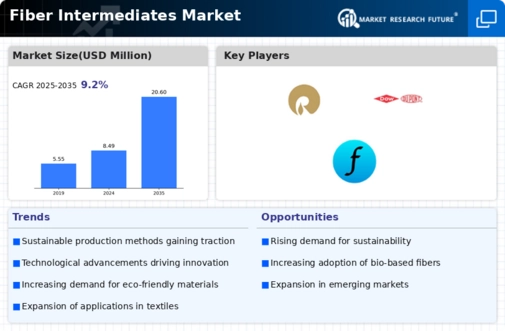Market Analysis
In-depth Analysis of Fiber Intermediates Market Industry Landscape
The Fiber Intermediates Market is subject to a variety of dynamic factors that collectively influence its growth, trends, and competitive landscape. Here's an exploration of the key market dynamics shaping the Fiber Intermediates Market, presented in a paragraph with a pointer format:
Textile Industry Dominance:
The Fiber Intermediates Market is significantly influenced by the textile industry, as fiber intermediates serve as essential precursors for the production of synthetic fibers. The demand for textiles, apparel, and home furnishings, especially in emerging economies, propels the growth of fiber intermediates. Polyester and Nylon Production Surge:
Polyester and nylon, derived from fiber intermediates, witness a surge in production. The versatility of polyester in textiles and the robust properties of nylon in various applications, including automotive and industrial sectors, contribute to the high demand for fiber intermediates. Asia-Pacific as a Key Market Driver:
The Asia-Pacific region emerges as a key driver for the Fiber Intermediates Market. The growth of manufacturing activities and the textile industry in countries like China and India fuels the demand for fiber intermediates, positioning the region as a dominant player in the market. Fluctuations in Crude Oil Prices:
The market is susceptible to fluctuations in crude oil prices as many fiber intermediates, such as PTA (purified terephthalic acid) and MEG (monoethylene glycol), are derived from petrochemical feedstocks. Variations in oil prices impact production costs and, consequently, the pricing and competitiveness of fiber intermediates. Emergence of Sustainable Alternatives:
The Fiber Intermediates Market experiences the emergence of sustainable alternatives and eco-friendly processes. Bio-based and recycled fiber intermediates gain traction as the industry responds to the growing demand for environmentally responsible practices and materials. Technological Innovations in Production Processes:
Continuous technological innovations drive advancements in fiber intermediate production processes. Manufacturers focus on improving efficiency, reducing energy consumption, and adopting cleaner technologies to enhance the sustainability of fiber intermediate manufacturing. Shift Towards Non-Woven Fabrics:
The market sees a shift towards the use of fiber intermediates in the production of non-woven fabrics. Non-woven materials find applications in hygiene products, medical textiles, and filtration, driving the demand for fiber intermediates beyond traditional textile uses. Focus on Specialty Fiber Intermediates:
There is a growing focus on specialty fiber intermediates with unique properties. High-performance intermediates, flame-retardant variants, and those tailored for specific applications in industries like automotive and healthcare gain prominence, contributing to market diversification. Globalization and Market Expansion:
The globalization of industries and increased market expansion contribute to the growth of the Fiber Intermediates Market. Companies explore opportunities in new regions, driving demand for fiber intermediates in areas experiencing industrial growth and infrastructure development. Regulatory Compliance and Environmental Standards:
Stringent regulatory compliance and adherence to environmental standards influence the Fiber Intermediates Market. Manufacturers strive to meet regulatory requirements and align with environmental standards to ensure the sustainable and responsible production of fiber intermediates. Capacity Expansions and Investments:
Capacity expansions and investments in production facilities are common dynamics in the Fiber Intermediates Market. Manufacturers invest in expanding their production capacities to meet growing demand, enhance operational efficiency, and capture market share. Impact of the COVID-19 Pandemic:
The Fiber Intermediates Market, like many industries, faced disruptions due to the COVID-19 pandemic. Supply chain challenges, reduced industrial activities, and shifts in consumer behavior influenced market dynamics, necessitating adaptability and resilience from industry players. Collaborations in the Value Chain:
Collaborations within the value chain are prevalent in the Fiber Intermediates Market. Manufacturers, suppliers, and end-users collaborate to optimize production processes, enhance product quality, and address challenges related to raw material sourcing and logistics. Growing Demand for Recycled and Circular Textiles:
The growing demand for recycled and circular textiles influences the Fiber Intermediates Market. As the textile industry embraces sustainability, there is an increased focus on using recycled fiber intermediates to produce eco-friendly fabrics, contributing to a circular economy approach.






Leave a Comment